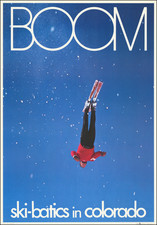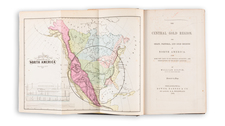Nice example of this Colorado Springs landmark, from Alfred Edward Mathews Pencil Sketches of Colorado, published in 1866.
A.E. Mathews (1831-1874) came to the United States at an early age and was raised in Ohio. He worked as a typesetter, itinerant bookseller, and school teacher, with a predilection for landscape sketching. During the Civil War, Mathews served in the Union Army with Ohio troops for three years, making topographical maps and views. and produced images of scenes behind the front which were issued by Ehrgott & Forbriger.
In 1865, Mathews moved to Denver, where he produced a number of portfolios of views of the Rocky Mountains, Colorado and Montana, including his important 1866 Pencil Sketches of Colorado.
Colorado Territory was formed following the discovery of gold in the mountains above Denver in 1858, which was followed by the 1859 Colorado Gold Rush. By the time Mathews arrived in Denver, it was one of the most important mining regions in America and the hub of commerce for the Rocky Mountains and Western Plains.
Mathews' work captured this transient and foundational moment in the history of Colorado. The work is very rare, with only a few complete sets changing hands in the prior decade and single plates from the work are often among the earliest accurate depictions of the regions sketched by Mathews.
Central City
The city is a historic mining settlement founded in 1859 during the Pike's Peak Gold Rush and came to be known as the "Richest Square Mile on Earth".
On May 6, 1859, during the Pike's Peak Gold Rush, John H. Gregory found a gold-bearing vein (the Gregory Lode) in Gregory Gulch between Black Hawk and Central City. Within two months many other veins were discovered, including the Bates, Gunnell, Kansas, and Burroughs. By 1860, as many as 10,000 prospectors had flocked to the town, then known as Mountain City, and surrounding prospects, but most soon left, many returning east.
The year 1863 brought the first attempt by hard rock miners to form a hard rock miners' union. Of 125 miners signing a union resolution in Central City, about fifty broke windows and doors at the Bob Tail mine, forcing other workers out. After a night of shooting and fighting, the union effort among Central City miners failed.
Many Chinese immigrants lived in Central City during the early days working the placer deposits of Gregory Gulch. They were forbidden work in the underground mines. Most of them are believed to have returned to China after making their stake.










![Colton's United States Shewing Military Stations, Forts &c. . . . 1861 [Shows Colorada!]](https://storage.googleapis.com/raremaps/img/small/95088.jpg)

![[Report and] Map of an Exploring Expedition to The Rocky Mountains in the Years 1842 and to Oregon & North California in the Years 1843-44 By Brevet Capt. J. C. Fremont of the Corps of Topographical Engineers . . .](https://storage.googleapis.com/raremaps/img/small/88488.jpg)
![[Montana, Wyoming, Colorado, Dakotas, etc] Reconnaissances in the Dacota Country By G.K. Warren](https://storage.googleapis.com/raremaps/img/small/82655.jpg)
![The Seasoned Traveler Goes By Train [Map of Denver and Rocky Mountain National Park]](https://storage.googleapis.com/raremaps/img/small/99861.jpg)